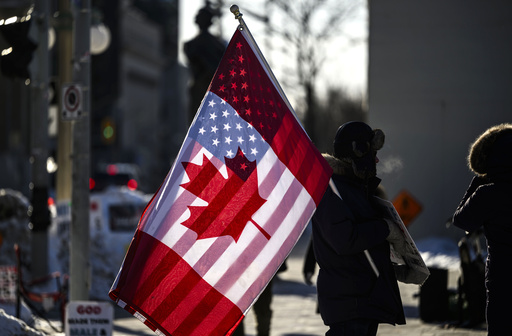
President Donald Trump has recently taken significant executive measures aimed at imposing new tariffs on imports from Canada, Mexico, and China. These actions fulfill some of his prior campaign commitments but have also caused ripples in the stock market and disrupted supply chains, while creating tensions with neighboring nations in North America and the world’s second-largest economy.
Contrary to the promises he made during his 2024 campaign, where he stated his economic strategies would lessen living costs for Americans, Trump now recognizes the potential fallout predicted by many economists: that these tariffs may lead to increased prices and diminished supplies in the market. Despite this acknowledgment, Trump touts a seeming victory following Mexico’s president agreeing to allocate national guard forces for drug trafficking control and border security.
Trump’s tariff announcements primarily impact the three largest trade partners of the United States. Initially, he declared an economic emergency, imposing a 10% tariff on all imports from China and a 25% tariff on imports from both Mexico and Canada. Additionally, energy resources imported from Canada—such as oil, natural gas, and electricity—would incur a 10% tax. As these countries are the U.S.’s principal trading partners, the implications are significant.
Reports suggested that the tariffs on Canada and China were set to be implemented on Tuesday. However, following discussions between Trump and Mexican President Claudia Sheinbaum, both parties agreed to postpone the escalation of trade conflicts for a month to enable further negotiations. Mexico has committed to sending 10,000 national guard members to the U.S.-Mexico border as part of this agreement.
The extent of these tariffs affects various sectors across the U.S. economy. For instance, Canada is a major supplier, exporting over 4.3 million barrels of oil daily to the U.S., which collectively consumes around 20 million barrels each day, according to the U.S. Energy Information Administration. Trump’s recent tariffs primarily target exports from Canada, which include oil and lumber, while also impacting products from Mexico, including produce and auto parts.
While Trump insists these tariffs address immigration and drug trafficking issues, rather than just economic concerns, he contends that the countries involved are failing to curb the influx of fentanyl and migrants into the U.S. Following his announcement, Sheinbaum has expressed her disbelief in Trump’s characterizations, though she committed to the deployment of national guard troops likely to provide Trump with a minor political advantage.
The responses from Canada, Mexico, and China were swift. In Trump’s order, he noted a promise to escalate tariffs should any of the U.S. trading partners respond with retaliatory actions. Prior to her conversation with Trump, Sheinbaum had arranged retaliatory tariffs, while Canadian Prime Minister Justin Trudeau indicated that he would impose equivalent 25% tariffs on approximately $155 billion worth of U.S. goods. Trudeau also urged Canadians to prioritize domestic products to counter U.S goods, prompting various Canadian provincial leaders to consider removing U.S. alcohol brands from their government-run stores.
While China refrained from imposing new tariffs on U.S. goods immediately, its Ministry of Foreign Affairs declared intentions to implement necessary actions to protect its interests. The Ministry of Commerce also announced plans to file a complaint with the World Trade Organization regarding what it termed the wrongful practices by the U.S., despite procedural delays affecting the WTO’s appeal process in recent years.
In terms of consumer impact, although direct payment of tariffs generally falls on companies—whether U.S.-based importers or foreign exporters—the overall cost is expected to inflate when goods reach their final retail destinations. As tariffs are implemented, companies are likely to increase their prices to account for the new tariffs, reflecting in consumer prices.
Economic expert Gregory Daco predicts an increase in inflation resulting from these tariffs, estimating an uptick of 0.4 percentage points in the current year. The Budget Lab at Yale University suggests that the average American household could see a reduction in purchasing power amounting to between $1,000 to $1,200 annually, a figure that assumes tariffs on Mexican exports would be included.
Consumer goods labeled “Made in the U.S.A.” might also be impacted, as this designation can occasionally mean that the product was merely assembled in the U.S. while still using materials sourced from abroad. Energy prices, significantly influenced by transportation costs, are another area at risk. Given that Canada is a crucial supplier of energy to the U.S., increased gas prices, particularly in the Midwest reliant on Canadian crude oil refineries, are anticipated.
Even amidst ongoing negotiations with foreign leaders, Trump’s actions continue to stir fluctuations in the market. He described his recent discussions with Sheinbaum as “very friendly,” maintaining that these economic actions are part of a negotiation framework. According to Trump, the tariffs might not be long-lasting, yet he remains firm that their potential implementation is an ongoing concern that could unsettle international markets and cause unease within U.S. businesses as they prepare for uncertainty.
Despite broad calls from business leaders for reduced taxes and regulatory easing, what they prioritize most is consistency, aiming to minimize unpredictable variables that could affect their financial projections. Following Trump’s pointed tariff announcements, U.S. stock markets exhibited volatility, signaling a period of apprehension among businesses leading into uncertainty.
Previously, Trump was resolute in his aggressive economic promises, stating that grocery prices would decline almost immediately and utility costs would be halved within a year of his presidency. He aimed to resolve crises attributed to rising expenses in housing and rent. Although he has heavily criticized the Biden administration for inflationary pressures on living costs, he is now notably tempering his predictions regarding the economic implications of his actions.
On Sunday, Trump acknowledged the likelihood of economic discomfort due to the tariffs, stating, “Will there be some pain? Yes, maybe (and maybe not). But we will make America great again, and it will all be worth the price that must be paid.”

